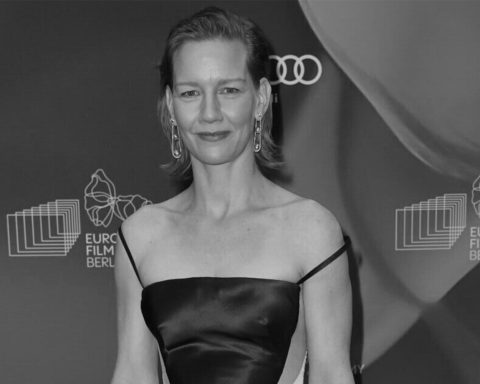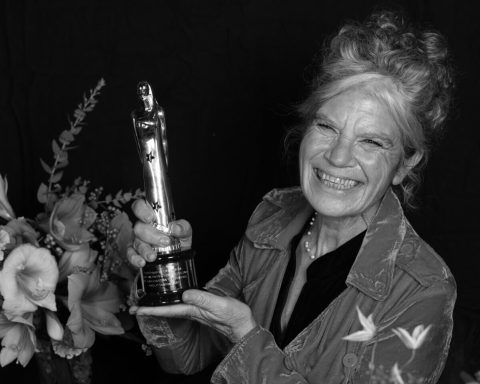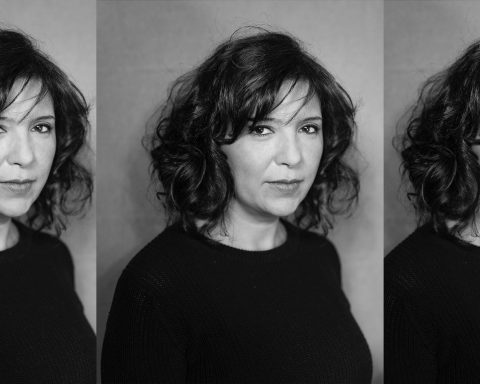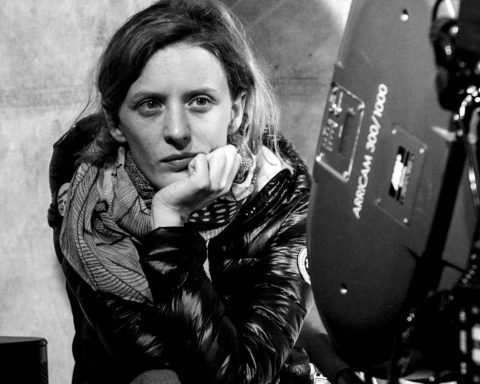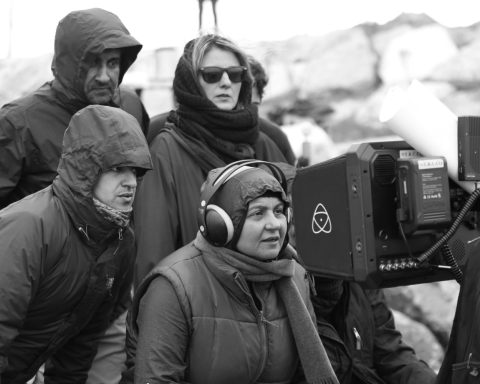Bianca Stigter is a historian and cultural critic. She writes essays for the Dutch newspaper NRC Handelsblad and was an associate producer on Steve McQueen’s “12 Years a Slave” and “Widows.” In 2019, she published the book “Atlas of an Occupied City: Amsterdam 1940-1945.”
Tara Karajica talks to Bianca Stigter about feminism and film as well as her debut feature, “Three Minutes – A Lengthening,” an essay about film, history and memory that examines carefully and poignantly a home movie shot in 1938 in a Jewish town in Poland and delays its ending. The film premiered in the Giornate degli Autori strand at the 2021 Venice Film Festival before successfully touring the festival circuit and now screening in the Europe! Voices of Women in Film program at this year’s Sydney Film Festival.
How did you get into filmmaking?
Bianca Stigter: I was working as a film critic when the Critic’s Choice strand at the International Film Festival Rotterdam asked me to make a video essay for their first program in 2015.
How did Three Minutes – A Lengthening come about?
B.S.: For the video essay, I thought of the three minutes of film I had recently seen on the website of the US Holocaust Memorial Museum in Washington after reading a Facebook post about the book Three Minutes in Poland. Discovering a Lost World in a 1938 Family Film by Glenn Kurtz. I thought it would be a good idea to make this footage from the past stay in our present a bit longer, to work against the fleeting passage of time, but really concentrate on it.
Three Minutes – A Lengthening is an essay about absence, film, history, and memory and questions the possibility of making those three minutes last longer to keep the past in the present. Can you comment on that?
B.S.: The film addresses all of these terrains, first and foremost the incredible wonder of movies and how we can work with found footage to make it as meaningful as possible.
What was your reaction when you first saw the footage?
B.S.: My first thought after watching the film for the first time on the website of the Holocaust Museum was the first idea for the film. I wanted to prolong it. It is great we have these minutes, but how could we make them less fleeting, more tangible? That also gave me the desire to find out everything about those minutes we possibly could, to really mine the celluloid for meaning.
You examine in a very detailed manner, seeing them almost as an archeological object, the existing three minutes of the footage to unravel the stories hidden in the celluloid, thus interrogating the past as well as the philosophical role and immersive essence of film. In that regard, Three Minutes – A Lengthening is the perfect example of the intrinsic relationship between film and history. Can you delve deeper into that?
B.S.: Film and photography have a different relationship to the past than other art forms. The mechanical recording can have a closer relationship with the truth. With old portrait paintings, for instance, you can almost never know if they depict a person accurately, however realistic they seem.
But it may well be that this is only true from the invention of those technological processes until now, some two hundred years, because it is now becoming so easy to tamper with photographic images that this close relationship might be lost. Deep fakes may change our relationship with this kind of recordings completely.
Even if entire communities were erased during the Holocaust, the footage is a record that the people depicted in the film existed, had lives and stories. In doing so, Three Minutes – A Lengthening affirms the presences of lives – lives taken too soon – but also their absence today, in order to understand what happened to them and what would their lives be like had History been different. In that sense, the film is a powerful essay on the importance of memory and heritage in culture and everyday life. Can you elaborate on that?
B.S.: Making the movie for me was a work against erasure, against forgetting. We are now almost entering the time where there are no eyewitnesses from the Holocaust anymore. Helping preserve these stories was very important for me. I hope watching also becomes a kind of commemorating. It was crucial to show all the people in the film as individuals, instead of symbols or abstractions. That is why we included a portrait gallery in the film.
What was the research process like? What did you learn while researching this topic, but also while making the film?
B.S.: Most research was already done by Glenn Kurtz for his book, Three Minutes in Poland, and we were very lucky he shared his knowledge and insights during interviews for the film. We could add a few things by focusing foremost on the visual aspects of the footage. A lot of research did not lead us anywhere because the footage was too damaged or too vague to come to any firm conclusions. We consulted a lip reader for instance, but she could not make out what the people in the film are saying.
Can you talk about the making and editing of the film and your choice of forgoing talking heads?
B.S.: I knew from the start I only wanted to show the old footage in a myriad of ways, so no talking heads. For me, the movie has become a kind of slow watching. It shows that really concentrating on a small thing can yield big results. We took our time with the editing and slowly found the rhythm to build the film up. We decided to focus on stories that are connected to what you can actually see on the footage. Sometimes, that meant stressing the absence of things.
How did Helena Bonham Carter become involved in the project? What was working with her on the film like? What do, according to you, her voice and narration bring to Three Minutes – A Lengthening?
B.S.: We asked Helena Bonham Carter because she has a beautiful English voice and I expected she could tell the story in a non-authoritarian way, as if she were discovering the material together with the viewer.
What were the challenges when making this particular film?
B.S.: It was my first film and I was lucky to get help from a lot of great, experienced professionals like the editor Katherina Wartena and the sound designers Marc Glynne and Tom Bijnen. They never winced at my questions.
You also wrote the book, Atlas of An Occupied City: Amsterdam 1940-1945, about Amsterdam during the Second World War, which is being adapted by Steve McQueen as a feature documentary titled Occupied City. Can you talk about that?
B.S.: The book came out in 2019 and I think of it as a kind of time machine on paper. Street by street, it tells you what happened in a particular location in Amsterdam during the Second World War, where the German troops were installed, where the Jewish citizens were rounded up, in what houses people went into hiding, where resistance groups were located and so on.
How do you balance your work as researcher, historian, critic and film producer? Is there a favorite hat among those you prefer to wear?
B.S.: It was great that for Three Minutes – A Lengthening it all came together. I could wear all those hats at the same time.
Are you a feminist? If so, how does this inform your filmmaking?
B.S.: Of course, I am a feminist! In the film, I wanted to make viewers aware of the fact that who tells what matters. In this case, for instance, we had a survivor that was a thirteen-year-old boy when the footage was made. Of course, this colors what and who he remembers and what we get to know. He does not remember the name of any girls because he was not allowed to look at girls.
What subjects interest you and that you would like to tackle in your work? What would you like audiences to come away with after watching your films?
B.S.: I am always interested in ways to tell History in a new way, that takes it away from the bookshelves, into our present. History is too important to forget.
Who is your favorite female filmmaker and what is your favorite film by a female filmmaker?
B.S.: One of my favorite films is a film by the Iranian poet Forugh Farrokhzad, The House is Black (1963). It is a short film about a leper colony. Delicately and boldly, she shows people that were forced to be invisible. Unfortunately, she died quite young in a car accident, so was not able to make more films.
There has been a lot of talk about the situation of women in the film industry these past four years. What is your take on the matter? How is it in The Netherlands?
B.S.: The Netherlands is doing well compared to other places perhaps, but there is still a lot of room for improvement.
What are you working on next?
B.S.: I have a few ideas…
Photo credits: ©Annaleen Louwes.
This interview was conducted in partnership with:

and







